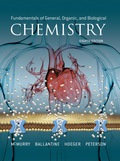
Concept explainers
(a)
Interpretation:
Given oxidation process should be draw and identified from the starting molecule of
Concept Introduction:
Oxidation: Generally alcohols can be oxidized to aldehyde or ketone. The aldehyde can be further oxidized to
(b)
Interpretation:
Given oxidation process should be draw and identified from the starting molecule of aliphatic aldehyde.
Concept Introduction:
Oxidation: Generally alcohols can be oxidized to aldehyde or ketone and aldehyde can be further oxidized to carboxylic acid. In aldehyde oxidation the hydrogen bonded to the carbonyl carbon is replaced by an hydroxyl group. Moreover ketones do not have this hydrogen, do not react cleanly with oxidizing agents.
Aldehydes
(c)
Interpretation:
The target molecule oxidation process should be draw and identified from the starting molecule of aliphatic aldehyde.
Concept Introduction:
Oxidation: Generally alcohols can be oxidized to aldehyde or ketone and aldehyde can be further oxidized to carboxylic acid. In aldehyde oxidation the hydrogen bonded to the carbonyl carbon is replaced by an hydroxyl group. Moreover ketones do not have this hydrogen, do not react cleanly with oxidizing agents.
Aldehydes
Want to see the full answer?
Check out a sample textbook solution
Chapter 15 Solutions
EBK FUNDAMENTALS OF GENERAL, ORGANIC, A
- Which type of enzyme catalyses the following reaction? oxidoreductase, transferase, hydrolase, lyase, isomerase, or ligase.arrow_forward+NH+ CO₂ +P H₂N + ATP H₂N NH₂ +ADParrow_forwardWhich type of enzyme catalyses the following reaction? oxidoreductase, transferase, hydrolase, lyase, isomerase, or ligase.arrow_forward
- Which features of the curves in Figure 30-2 indicates that the enzyme is not consumed in the overall reaction? ES is lower in energy that E + S and EP is lower in energy than E + P. What does this tell you about the stability of ES versus E + S and EP versus E + P.arrow_forwardLooking at the figure 30-5 what intermolecular forces are present between the substrate and the enzyme and the substrate and cofactors.arrow_forwardprovide short answers to the followings Urgent!arrow_forward
- Pyruvate is accepted into the TCA cycle by a “feeder” reaction using the pyruvatedehydrogenase complex, resulting in acetyl-CoA and CO2. Provide a full mechanismfor this reaction utilizing the TPP cofactor. Include the roles of all cofactors.arrow_forwardB- Vitamins are converted readily into important metabolic cofactors. Deficiency inany one of them has serious side effects. a. The disease beriberi results from a vitamin B 1 (Thiamine) deficiency and ischaracterized by cardiac and neurological symptoms. One key diagnostic forthis disease is an increased level of pyruvate and α-ketoglutarate in thebloodstream. How does this vitamin deficiency lead to increased serumlevels of these factors? b. What would you expect the effect on the TCA intermediates for a patientsuffering from vitamin B 5 deficiency? c. What would you expect the effect on the TCA intermediates for a patientsuffering from vitamin B 2 /B 3 deficiency?arrow_forwardDraw the Krebs Cycle and show the entry points for the amino acids Alanine,Glutamic Acid, Asparagine, and Valine into the Krebs Cycle - (Draw the Mechanism). How many rounds of Krebs will be required to waste all Carbons of Glutamic Acidas CO2?arrow_forward
 Biology Today and Tomorrow without Physiology (Mi...BiologyISBN:9781305117396Author:Cecie Starr, Christine Evers, Lisa StarrPublisher:Cengage Learning
Biology Today and Tomorrow without Physiology (Mi...BiologyISBN:9781305117396Author:Cecie Starr, Christine Evers, Lisa StarrPublisher:Cengage Learning Anatomy & PhysiologyBiologyISBN:9781938168130Author:Kelly A. Young, James A. Wise, Peter DeSaix, Dean H. Kruse, Brandon Poe, Eddie Johnson, Jody E. Johnson, Oksana Korol, J. Gordon Betts, Mark WomblePublisher:OpenStax College
Anatomy & PhysiologyBiologyISBN:9781938168130Author:Kelly A. Young, James A. Wise, Peter DeSaix, Dean H. Kruse, Brandon Poe, Eddie Johnson, Jody E. Johnson, Oksana Korol, J. Gordon Betts, Mark WomblePublisher:OpenStax College





